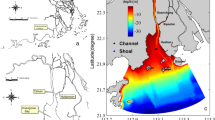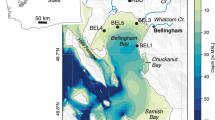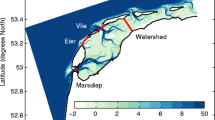Abstract
Although the supply and fate of suspended sediment is of fundamental importance to the functioning and morphological evolution of muddy estuaries, reliable sediment budgets have been established in only a few cases. Especially for smaller estuaries, inadequate bathymetric surveys and a lack of intertidal sedimentation data often preclude estimation of the sediment budget from morphological change, while instrument-derived residual fluxes typically lie well within the errors associated with measurement of much larger gross tidal transports. Given suitably long-term records of continuously monitored suspended sediment concentration (SSC), however, analysis of the major scales of variation in sediment transport and their relation to hydrodynamic and meteorological forcing permits qualitative testing of hypotheses suggested by directly measured residual fluxes. This paper analyzes data from a 1-year acoustic Doppler profiler deployment in the Blyth estuary, a muddy mesotidal barrier-enclosed system on the UK east coast. Flux calculations indicate a small sediment import equivalent to just 1.5% of the gross flood tide transport. Little confidence can be assigned to either the magnitude or direction of such a small residual when considered in isolation. However, the inference that the sediment regime is finely balanced is qualitatively supported by the close similarity between flood-tide and ebb-tide SSC values. Singular spectrum analysis of the SSC time series shows the expectedly large contributions to the variance in SSC at intratidal and subtidal (semimonthly and monthly) scales but also picks out intermittent variability that is initially attributed to a combination of non-tidal surge and wind stress forcing. Closer examination of the data through cross-correlograms and event-scale analysis indicates that local meteorological forcing is the major factor. Acting through the resuspension of intertidal mudflat sediments at times of strong westerlies, meteorological forcing is directly implicated in episodic sediment export from the estuary. Thresholding of tide-averaged fluxes using a range of critical wind stress values further indicates that ‘tide-dominated’ (i.e., low wind stress) and ‘wave-dominated’ (high wind stress) conditions are associated with sediment import and export. Sediment balance is potentially sensitive to the frequency of high wind stress events, since the associated sediment exports are several times larger than the average import under calm conditions. Intermittent meteorological forcing may thus exert an important control on the sedimentary balance of otherwise tidally dominated muddy estuarine systems, and the role of wind climate should not be overlooked in studies of estuary response to environmental change.











Similar content being viewed by others
References
Alvarez, L.G., and S.E. Jones. 2002. Factors influencing suspended sediment flux in the upper Gulf of California. Estuarine, Coastal and Shelf Science 54: 747–759. doi:10.1006/ecss.2001.0873.
Baird, P., E.D. Winter, and G. Wendt. 1987. The flux of particulate material through a well mixed estuary. Continental Shelf Research 7: 1399–1403. doi:10.1016/0278-4343(87)90044-6.
Beardall, C.H., R.C. Dryden, and T.J. Holzer. 1991. The Suffolk estuaries: report by the Suffolk Wildlife Trust on the wildlife and conservation of the Suffolk estuaries. Ipswich: Segment Publications.
Benson, T., and J.R. French. 2007. InSiPID: a new low cost instrument for in situ particle size measurements in estuarine and coastal waters. Journal of Sea Research 58: 167–188. doi:10.1016/j.seares.2007.04.003.
Brew, D.S., B.M. Funnell, and A. Kreiser. 1992. Sedimentary environments and Holocene evolution of the lower Blyth estuary, Suffolk England, and a comparison with other East Anglian coastal sequences. Proceedings of the Geologists Association 103: 57–74.
Broomhead, D.S., and G.P. King. 1986. Extracting qualitative dynamics from physical data. Physica D 20: 217–236. doi:10.1016/0167-2789(86)90031-X.
Bunt, J.A.C., P. Larcombe, and C.F. Jago. 1999. Quantifying the response of optical backscatter devices and transmissometers to variations in suspended particulate matter. Continental Shelf Research 19: 1199–1220. doi:10.1016/S0278-4343(99)00018-7.
Burningham, H., and J.R. French. 2006. Morphodynamic behaviour of a sand-gravel ebb-tidal delta: Deben estuary inlet, Suffolk, UK. Marine Geology 225: 23–44. doi:10.1016/j.margeo.2005.09.009.
Burningham, H., and J.R. French. 2007. Morphodynamics and sedimentology of mixed-sediment inlets. Journal of Coastal Research Special Issue 50: 710–715.
CEFAS 2004. Centre for Environment Fisheries and Aquaculture Science: WaveNet. http://map.cefasdirect.co.uk/wavenetmapping/advanced.asp (accessed 15 June, 2007).
Chen, M.S., S. Wartel, B. Van Eck, and D. Van Maldegem. 2005. Suspended matter in the Scheldt estuary. Hydrobiologia 540: 79–104. doi:10.1007/s10750-004-7122-y.
Corbett, D.R., D. Vance, E. Letrick, D. Mallinson, and S. Culver. 2007. Decadal-scale sediment dynamics and environmental change in the Albemarle Estuarine System, North Carolina. Estuarine Coastal and Shelf Science 71: 717–729. doi:10.1016/j.ecss.2006.09.024.
Dronkers, J. 1986. Tidal asymmetry and estuarine morphology. Netherlands Journal of Sea Research 20: 117–131. doi:10.1016/0077-7579(86)90036-0.
Dyer, K.R., and T.J. Moffat. 1998. Fluxes of suspended matter in the East Anglian plume, Southern North Sea. Continental Shelf Research 18: 1311–1331. doi:10.1016/S0278-4343(98)00045-4.
Eisma, D., and J. Kalf. 1987. Dispersal, concentration and deposition of suspended matter in the North Sea. Journal of the Geological Society, London 144: 161–78. doi:10.1144/gsjgs.144.1.0161.
French, C.E., J.R. French, N.J. Clifford, and C.J. Watson. 2000. Sedimentation–erosion dynamics of abandoned reclamations: the role of waves and tides. Continental Shelf Research 20: 1711–1733.
French, J.R., T. Benson, and H. Burningham. 2005. Morphodynamics and sediment flux in the Blyth estuary, Suffolk, UK: conceptual modelling and high resolution monitoring. In Morphodynamics and sedimentary evolution of estuaries, eds. D.M. Fitzgerald, and J. Knight, 143–171. New York: Springer.
French, J.R. 2008. Hydrodynamic modelling of estuarine flood defence realignment as an adaptive management response to sea-level rise. Journal of Coastal Research 24–2B: 1–12.
Frostick, L.E., and I.N. McCave. 1979. Seasonal shifts of sediment within an estuary mediated by algal growth. Estuarine and Coastal Marine Science 9: 569–576. doi:10.1016/0302-3524(79)90080-X.
Gayer, G., S. Dick, A. Pleskachevsky, and W. Rosenthal. 2006. Numerical modeling of suspended matter transport in the North Sea. Ocean Dynamics 56: 62–77. doi:10.1007/s10236-006-0070-5.
Goodwin, P., A.J. Mehta, and J.B. Zedler. 2001. Tidal wetland restoration: an introduction. Journal of Coastal Research Special Issue 27: 1–6.
Grabeman, I., and G. Krause. 2001. On different time scales of suspended matter dynamics in the Weser Estuary. Estuaries 24: 688–698. doi:10.2307/1352877.
Guezennec, L., R. Lafite, J.-P. Dupont, R. Meyer, and D. Boust. 1999. Hydrodynamics of suspended sediment matter in the tidal freshwater zone of a macrotidal estuary (the Seine Estuary, France). Estuaries 22: 717–727. doi:10.2307/1353058.
Hoitink, A.J.F., and P. Hoekstra. 2005. Observations of suspended sediment from ADCP and OBS measurements in a mud-dominated environment. Coastal Engineering 52: 103–118. doi:10.1016/j.coastaleng.2004.09.005.
Holdaway, G.P., P.D. Thorne, D. Flatt, S.E. Jones, and D. Prandle. 1999. Comparison between ADCP and transmissometer measurements of suspended sediment concentration. Continental Shelf Research 19: 421–41. doi:10.1016/S0278-4343(98)00097-1.
HR Wallingford. 2001. Bathside Bay development studies: impact of proposed scheme on sediment transport and morphology. Wallingford, HR Wallingford Report, EX-4426.
HR Wallingford. 2002. Southern North Sea Sediment Transport Study, Phase 2. Wallingford, HR Wallingford Report, EX-4526.
Hulme, M., G.J. Jenkins, X. Lu, J.R. Turnpenny, T.D. Mitchell, R.G. Jones, J. Lowe, J.M. Murphy, D. Hassell, P. Boorman, R. McDonald, and S. Hill 2002. Climate change scenarios for the United Kingdom: The UKCIP02 scientific report. Tyndall Centre for Climate Change Research, University of East Anglia, UK, 120pp.
Jay, D.A., R.J. Uncles, J. Largier, W.R. Geyer, J. Vallino, and W.R. Boynton. 1997. A review of recent developments in estuarine scalar flux estimation. Estuaries 20: 262–280. doi:10.2307/1352342.
Kjerfve, B., and J.A. Proehl. 1979. Velocity variability in a cross-section of a well-mixed estuary. Journal of Marine Research 37: 409–418.
Kostaschuk, R., J. Best, P. Villard, J. Peakall, and M. Franklin. 2005. Measuring flow velocity and sediment transport with an acoustic Doppler current profiler. Geomorphology 68: 25–37. doi:10.1016/j.geomorph.2004.07.012.
Land, J.M., and R.N. Bray. 1998 Acoustic measurement of suspended solids for monitoring of dredging and dredged material disposal. Proceedings of the 15th World Dredging Congress 1998, Las Vegas, Western Dredging Association.
Lane, A., D. Prandle, A.J. Harrison, P.D. Jones, and C.J. Jarvis. 1997. Measuring fluxes in tidal estuaries: sensitivity to instrumentation and associated data analyses. Estuarine Coastal and Shelf Science 45: 433–451. doi:10.1006/ecss.1996.0220.
Lees, B. 1980. Sizewell-Dunwich Banks field study. Institute of Oceanographic Sciences Report 88.
Lunven, M., and P. Gentien. 2000. Suspended sediments in a macrotidal estuary: comparison and use of different sensors. Oceanolgica Acta 23: 245–260. doi:10.1016/S0399-1784(00)00126-2.
McCave, I.N. 1987. Fine sediment sources and sinks around the East Anglian coast (UK). Journal of The Geological Society, London 144: 149–152. doi:10.1144/gsjgs.144.1.0149.
Pontee, N.I., K. Pye, and S.J. Blott. 2004. Morphodynamic behaviour and sedimentary variation of mixed sand and gravel beaches, Suffolk, UK. Journal of Coastal Research 20: 256–276. doi:10.2112/1551-5036(2004)20[256:MBASVO]2.0.CO;2.
Pugh, D.T. 1987. Tides, surges and mean sea-level. 472. Chichester: Wiley.
RDI. 1999. River TRANSECT user manual. San Diego: RD Instruments.
Reichel, G., and H.P. Nachtnebel. 1994. Suspended sediment monitoring in a fluvial environment — Advantages and limitations of applying an acoustic-Doppler-current-profiler. Water Research 28: 751–761. doi:10.1016/0043-1354(94)90083-3.
Robert, S., G. Blanc, J. Schafer, G. Lavaux, and G.L. Abril. 2004. Metal mobilization in the Gironde Estuary (France): the role of the soft mud layer in the maximum turbidity zone. Marine Chemistry 87: 1–13. doi:10.1016/S0304-4203(03)00088-4.
Roberts, W., M.P. Dearnaley, J.V. Baugh, J.R. Spearman, and R.S. Allen. 1998. The sediment regime of the Stour and Orwell estuaries. In Physics of estuaries and coastal seas, eds. J. Dronkers, and M. Scheffers, 93–102. Rotterdam: AA Balkema.
Schoellhamer, D.H. 1996. Factors affecting suspended-solids concentrations in South San Francisco Bay. Journal of Geophysical Research C 101: 12087–12095. doi:10.1029/96JC00747.
Schoellhamer, D.H. 2001. Singular spectrum analysis for time series with missing data. Geophysical Research Letters 28: 3187–3190. doi:10.1029/2000GL012698.
Schoellhamer, D.H. 2002. Variability of suspended-sediment concentration at tidal to annual time scales in San Francisco Bay, USA. Continental Shelf Research 22: 1857–1866. doi:10.1016/S0278-4343(02)00042-0.
Simper, R. 1994. Rivers Alde, Ore and Blyth. 84. Lavenham: Creekside Publishing.
Simpson, M.R., and R. Bland. 2000. Accurate estimation of net discharge in a tidal channel. IEEE Journal of Oceanic Engineering 25: 437–445. doi:10.1109/48.895351.
Smith, S.D. 1988. Coefficients for sea surface wind stress. Journal of Geophysical Research 93: 15467–15472. doi:10.1029/JC093iC12p15467.
Spencer, K.L. 2002. Spatial variability of metals in the inter-tidal sediments of the Medway Estuary, Kent, UK. Marine Pollution Bulletin 449: 933–944. doi:10.1016/S0025-326X(02)00129-7.
Taylor, J.A., A.P. Murdoch, and N.I. Pontee. 2004. A macroscale analysis of coastal steepening around the coast of England and Wales. Geographical Journal 170: 179–188. doi:10.1111/j.0016-7398.2004.00119.x.
Townend, I., and J. Pethick. 2002. Estuarine flooding and managed retreat. Philosophical Transactions Royal Society of London A 360: 1477–1495. doi:10.1098/rsta.2002.1011.
Townend, I., and P. Whitehead. 2003. A preliminary net sediment budget for the Humber Estuary. Science of the Total Environment 314: 755–767. doi:10.1016/S0048-9697(03)00082-2.
Vautard, R., and M. Ghil. 1989. Singular-spectrum analysis in nonlinear dynamics, with applications to palaeoclimatic time series. Physica D 35: 395–424. doi:10.1016/0167-2789(89)90077-8.
Vautard, R., P. Yiou, and M. Ghil. 1992. Singular-spectrum analysis: a toolkit for short, noisy, chaotic signals. Physica D 58: 95–126. doi:10.1016/0167-2789(92)90103-T.
Winn, P.J.S., R.M. Young, and A.M.C. Edwards. 2003. Planning for the rising tides: the Humber estuary Shoreline Management Plan. The Science of the Total Environment 314–316: 13–30. doi:10.1016/S0048-9697(03)00092-5.
Acknowledgments
The authors thank Drs David Gasca and Daniel Robinson and the Southwold Harbour Master, Mr Ken Howells, for their invaluable assistance with the data acquisition campaign. The provision of data from the National River Flow Archive and the NERC British Atmospheric Data Centre is gratefully acknowledged.
Author information
Authors and Affiliations
Corresponding author
Rights and permissions
About this article
Cite this article
French, J.R., Burningham, H. & Benson, T. Tidal and Meteorological Forcing of Suspended Sediment Flux in a Muddy Mesotidal Estuary. Estuaries and Coasts 31, 843–859 (2008). https://doi.org/10.1007/s12237-008-9072-5
Received:
Revised:
Accepted:
Published:
Issue Date:
DOI: https://doi.org/10.1007/s12237-008-9072-5




